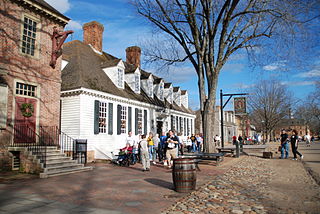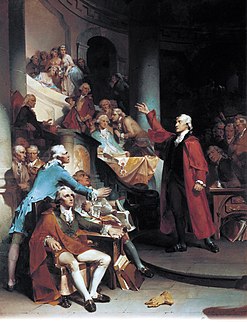
James City County is a county located in the Commonwealth of Virginia. As of the 2010 census, the population was 67,009. Although politically separate from the county, the county seat is the adjacent independent city of Williamsburg.

Nelson Wilmarth Aldrich was a prominent American politician and a leader of the Republican Party in the United States Senate, where he served from 1881 to 1911. By the 1890s he was one of the "Big Four" key Republicans who largely controlled the major decisions of the Senate, along with Orville H. Platt, William B. Allison and John Coit Spooner. Because of his impact on national politics and central position on the pivotal Senate Finance Committee, he was referred to by the press and public alike as the "General Manager of the Nation", dominating tariff and monetary policy in the first decade of the 20th century.

The Virginia Peninsula is a peninsula in southeast Virginia, USA, bounded by the York River, James River, Hampton Roads and Chesapeake Bay. It is sometimes known as the Lower Peninsula to distinguish it from two other peninsulas to the north, the Middle Peninsula and the Northern Neck.
The Rockefeller family is an American industrial, political, and banking family that owns one of the world's largest fortunes. The fortune was initially made in the American petroleum industry during the late 19th and early 20th centuries by John D. Rockefeller and his brother William Rockefeller, primarily through Standard Oil. The family is also known for its long association with, and control of, Chase Manhattan Bank. The Rockefellers are considered to be one of the most powerful families, if not the most powerful family, in the history of the United States.
William Archer Rutherfoord Goodwin was an Episcopal priest, historian, and author. As the rector of Bruton Parish Church, Goodwin began the 20th century preservation and restoration effort which resulted in Colonial Williamsburg in Virginia. He is thus sometimes called "the Father of the Restoration of Colonial Williamsburg."

The Governor's Palace in Williamsburg, Virginia was the official residence of the Royal Governors of the Colony of Virginia. It was also a home for two of Virginia's post-colonial governors, Patrick Henry and Thomas Jefferson, until the capital was moved to Richmond in 1780, and with it the Governor's residence. The main house burned down in 1781, though the outbuildings survived for some time after.

The Capitol at Williamsburg, Virginia housed the House of Burgesses of the Colony of Virginia from 1705, when the capital was relocated there from Jamestown, until 1779, when the capital was relocated to Richmond. Two capitol buildings served the colony on the same site: the first from 1705 until its destruction by fire in 1747; the second from 1753 to 1779.
Kingsmill is a geographic area in James City County, Virginia, that includes a large planned residential community, a resort complex, a theme park, a brewery, and a commercial park.

The Raleigh Tavern was a tavern in Williamsburg, Virginia, and was one of the largest taverns in colonial Virginia. It gained some fame in the pre-American Revolutionary War Colony of Virginia as a gathering place for legislators after several Royal Governors officially dissolved the House of Burgesses, the elected legislative body, when their actions did not suit the Crown. It was also the site of the founding of the Phi Beta Kappa Society on December 5, 1776.
Parke Shepherd Rouse Jr. was an American journalist, writer and historian in Tidewater Virginia.

The DeWitt Wallace Decorative Arts Museum (DWDAM), is a museum dedicated to British and American fine and decorative arts from 1670-1840, located in Williamsburg, Virginia.

Vernon Meredith Geddy Sr. was an attorney based in Williamsburg, Virginia. He attended the College of William and Mary and the University of Virginia, and served W&M as the head coach for the William & Mary Tribe men's basketball team for the 1918–19 season.

Williamsburg, Virginia, has had a long history dating to the 17th century. The city was first named Middle Plantation and changed its name to Williamsburg in 1699.

The history of Hampton Roads dates to 1607, when Jamestown was founded. Two wars have taken place in addition to many other historical events.

Julian Alvin Carroll "J. A. C." Chandler was an American historian, author and educator. He is best known as the 18th president of The College of William and Mary in Williamsburg, Virginia, where he served as the successor to retiring fellow educator and author Dr. Lyon Gardiner Tyler. Dr. Chandler is credited with transforming the institution from a small, struggling liberal arts college for men into a modern coeducational institution of higher learning.

The Abby Aldrich Rockefeller Folk Art Museum (AARFAM) is the United States' first and the world's oldest continually-operated museum dedicated to the preservation, collection, and exhibition of American folk art.




















